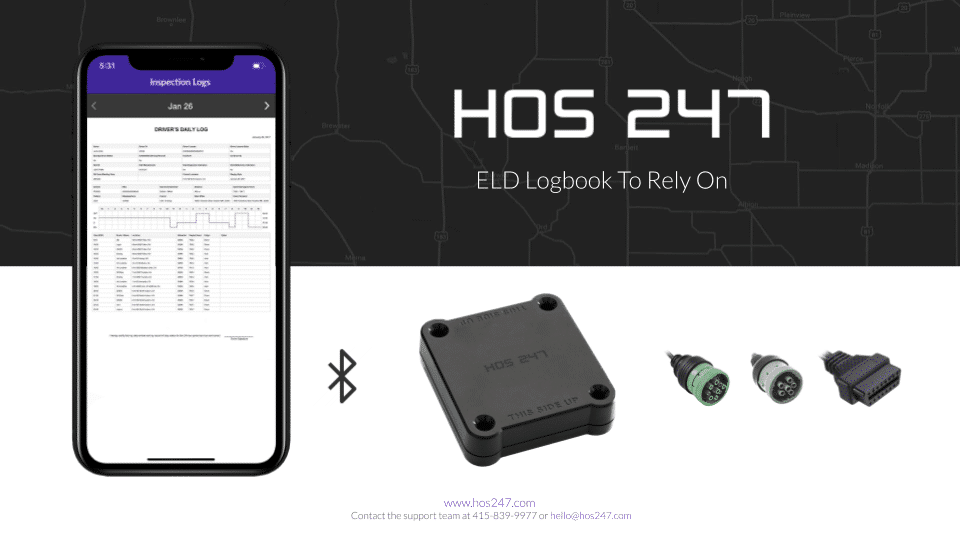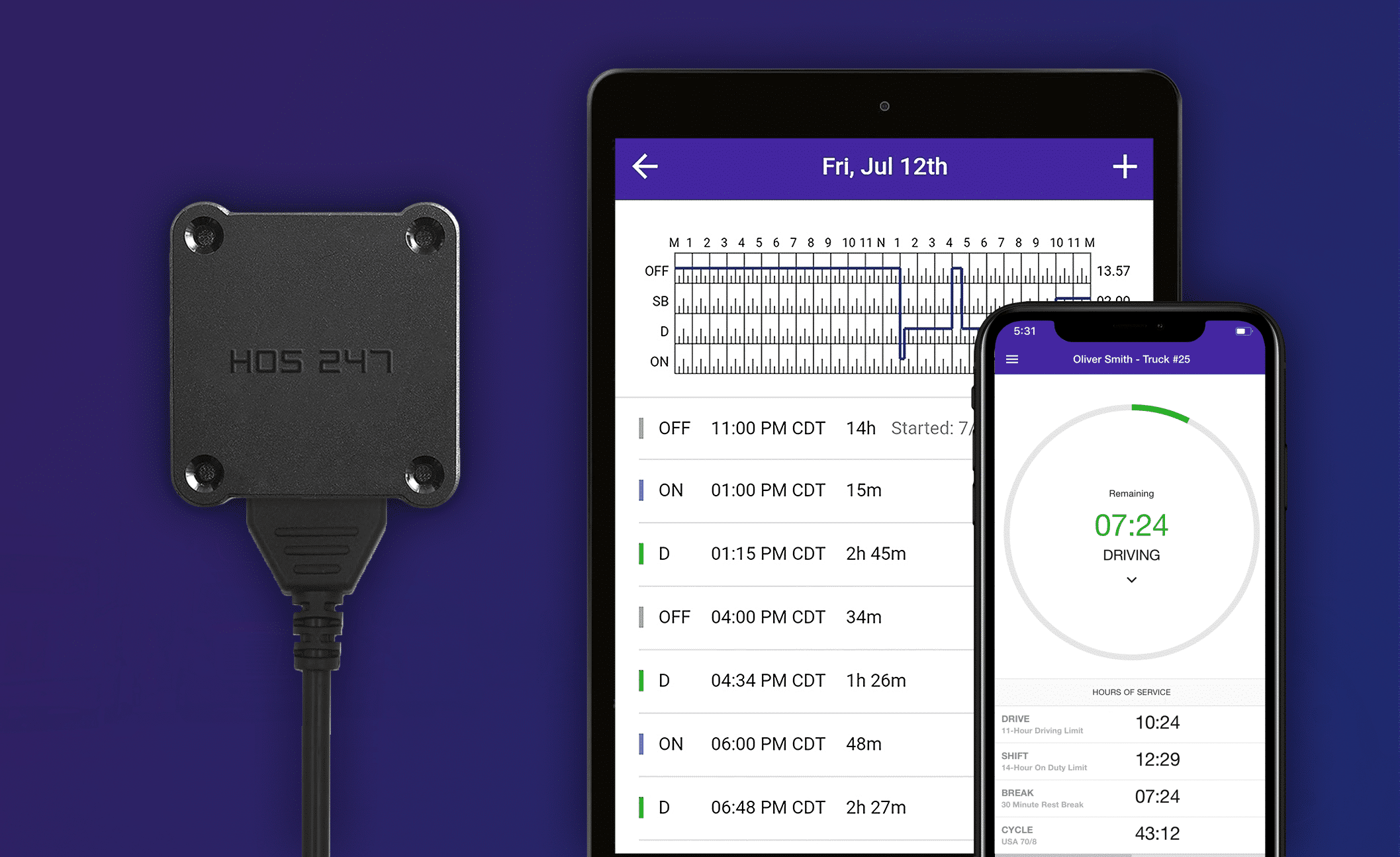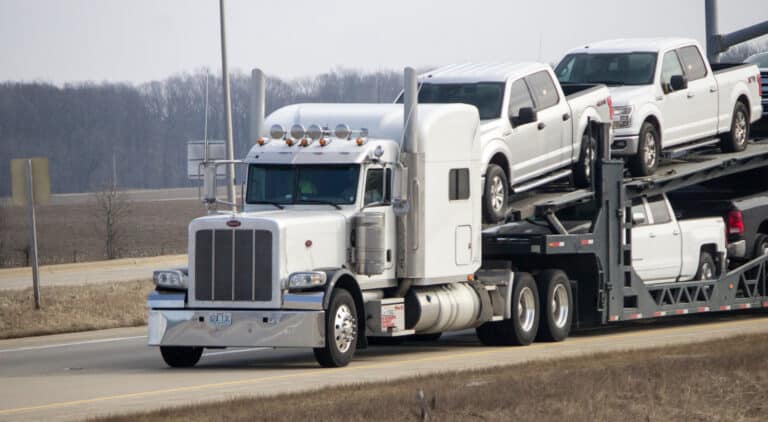As the trucking industry advances, the adoption of electronic logging devices (ELDs) is reshaping how commercial motor vehicle (CMV) drivers maintain their records of duty status (RODS). This article sheds light on key differences between paper and electronic CMV logbooks, ELD applicability for different vehicle types, intrastate requirements, and the advantages of HOS247 as a leading ELD provider.
CMV Logbook Types
According to the Federal Motor Carrier Safety Administration (FMCSA), a paper logbook refers to a physical, handwritten or printed document to record their hours of service (HOS). Computerized logs are still considered paper logs if not recorded by an engine-connected device.
Do you have any questions? Talk to ELD Advisor: 650-405-3372 or Request Callback
For decades, paper logs were used to keep track of drivers’ working hours. This changed with the implementation of the mandate, and now most CMV drivers must keep electronic logs. While both electronic logging devices and traditional paper logs share the fundamental goal of tracking a driver’s HOS, their mechanics and advantages paint a very different picture. Let’s explore the main distinctions that set these two methods apart:
- Automation vs. manual input. ELDs offer a streamlined and automated approach. These advanced devices seamlessly integrate with a vehicle’s engine, automatically logging driving hours without the need for manual data entry. This minimizes the potential for human errors associated with handwritten records. On the other hand, paper logs require drivers to manually record each driving session, encompassing start times, stops, and distances covered. While a classic approach, it can lead to inaccuracies, omitted entries, and operational inefficiencies.
- Precision and accuracy. ELDs eliminate the need for manual calculations, ensuring that driving hours are accurately and comprehensively recorded. The systematic digital tracking leaves no room for miscalculations or uncertainties, enhancing overall compliance. In contrast, paper logs are susceptible to mathematical errors and inconsistencies. Adding up hours and calculating driving intervals manually requires more time and introduces the potential for mistakes that could impact regulatory compliance.
- Handling malfunctions. In the event of an ELD malfunction, drivers are typically required to switch temporarily to paper logs to maintain compliance.
Today, ELDs represent the contemporary standard for hours of service tracking. Their automation, precision, and adaptability contribute to compliant operations.

What CMV Drivers Must Use Electronic Logbooks?
When it comes to the ELD mandate, the weight of the CMV becomes a pivotal factor. The FMCSA mandates that most motor carriers and drivers who need to maintain RODS and are involved in interstate commerce are subject to the ELD Rule. This encompasses any OBD2-equipped CMV, whether it operates independently or with an attached trailer, as long as its weight equals or exceeds 10,001 pounds.
There are two primary weight ratings to determine whether a CMV meets the weight requirement to qualify for mandated ELD implementation:
- Gross Vehicle Weight Rating (GVWR). This manufacturer-defined value establishes the maximum weight at which a vehicle can safely operate. GVWR considers various components, including engine fluids, cargo, passengers, and any weight borne while driving.
- Gross Combination Weight Rating (GCWR). Aligned with GVWR, the GCWR also includes the weight of attached trailers and their contents, presenting a comprehensive evaluation of a CMV’s load-bearing capacity.
The threshold for ELD compliance is a GVWR or GCWR exceeding 10,001 pounds. Vehicles meeting this criterion are classified as CMVs and are subject to adhering to hours of service (HOS) regulations.
However, there are specific exemptions and exceptions to the ELD mandate, including:
- Drivers who operate within a 150 air-mile radius of their work reporting location and satisfy certain conditions (known as the short-haul exemption).
- Drivers who keep RODS for no more than eight days within any 30-day period.
- Drive-away-tow-away operations, where the vehicle being driven is part of the shipment.
- Vehicles manufactured before the year 2000 (although some may still need to comply with ELD requirements if they meet certain criteria).
Intrastate ELD Requirements
Intrastate, in the context of trucking and transportation, refers to commercial motor vehicle operations that occur solely within the boundaries of a specific state, without crossing state lines. While interstate operations involve the movement of goods and vehicles at a federal level, intrastate operations focus exclusively on activities conducted within one state. As ELDs became federally mandated, some states decided to update their intrastate regulations to include ELD requirements, ensuring uniformity and compliance. Here are a few examples:
- California. California has implemented ELD requirements for intrastate CMV drivers in alignment with the federal regulations. The California Air Resources Board (CARB) oversees these regulations, which aim to improve air quality and ensure compliance with hours of service (HOS) rules.
- Texas. Texas also requires intrastate CMV drivers to use ELDs to track their driving hours. The Texas Department of Public Safety (DPS) enforces these regulations, which are designed to enhance safety and promote accurate HOS recording.
- Washington. Intrastate CMV drivers in Washington are subject to ELD requirements. The Washington State Department of Transportation (WSDOT) oversees the implementation of these regulations to ensure consistent and accurate HOS tracking.
- Oregon. Oregon has adopted ELD requirements for intrastate CMV drivers. The Oregon Department of Transportation (ODOT) enforces these regulations to improve compliance with HOS rules and enhance road safety.
- Utah. Utah is another state that has implemented ELD requirements for intrastate CMV drivers. The Utah Department of Transportation (UDOT) oversees these regulations to ensure that drivers accurately record their driving hours.
It is important for intrastate drivers to stay informed about their state’s regulations and specific compliance requirements. Ask your current or potential ELD provider about supporting these rules to avoid fines and disruptions in operations.
HOS247 Is a Top-Rated ELD Provider
Choosing a reputable ELD provider like HOS247 is essential to conduct efficient and compliant operations. HOS247 offers electronic logbook devices specifically tailored for various light-duty and medium-duty CMVs, including pickup trucks. As you navigate the nuances of weight ratings and ELD mandates, the support and expertise of HOS247 will help you remain confidently compliant while optimizing your trucking operations.
The HOS247 electronic logging system supports all applicable federal and state HOS rules to keep truckers compliant and productive. Here’s why truckers across the nation are choosing HOS247:
- Top-rated customer support. Our customer support reps are available Monday through Sunday to help with any issues that might arise. Also, we understand that effective communication is essential. That’s why our multilingual customer support team is proficient in English, Spanish, Russian, and Polish. No matter your preferred language, we’re here to ensure your queries are met with swift and accurate resolutions.
- Driver-centric approach. We’ve revolutionized the logging experience with truckers in mind. HOS247’s user-friendly logbook app features an intuitive design that streamlines the tracking process, ultimately boosting driver satisfaction and performance.
- Quality hardware. Our reliable hardware guarantees a trouble-free installation process, reinforced by a one-year free replacement warranty.

- Seamless connectivity. Stable Bluetooth connectivity ensures flawless data transfer between the hardware and app, ensuring consistent and dependable reporting.
- Operational optimization. Real-time GPS enhances fleet visibility, while driver vehicle inspection reports and fault code notifications contribute to enhanced safety and prolonged vehicle longevity.
- Flexibility. HOS247 operates under a no-contract policy, a two-week trial period with straightforward returns, and subscription plans that can be paid monthly or yearly to accommodate each carrier’s needs.
- Cost savings. With our FMCSA-registered ELD, you can steer clear of costly violations and streamline your operations, thereby reducing expenses and increasing profitability.
In an evolving trucking landscape, adopting ELDs is no longer a choice but a necessity for streamlined operations, compliance, and heightened safety. HOS247 is here to support your trucking journey with efficient and compliant ELD solutions.

I’ve co-founded, built and managed several transportation-related businesses. Now, I’m a founder and CEO of HOS247 – an AI Transportation Platform for trucking companies, freight brokers and other logistics operations. We are transitioning old-style operations to technology-advanced logistics entities and help them to grow their businesses. ELDs (electronic logging devices), fleet tracking and management 2.0 combined with AI-powered dispatch tools.












Since the ELD mandate’s implementation in 2017, electronic logbooks have become an integral working tool both for CMV drivers and fleet managers. But, what does ELD stand for? ELD stands for electronic logging device. These digital tools must be used

Your electronic logging device (ELD) is as essential to your daily operations as your truck itself. The right ELD phone app can make your life easier on the road, while the wrong one can cause issues during DOT inspections and

It is no secret that most truck drivers fall into the category of those who must comply with the HOS rules. Keeping track of hours and managing a trucking company can feel like a monumental feat at times. Companies need